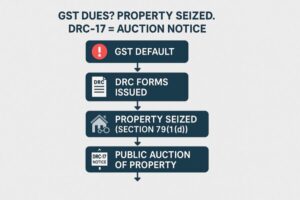Letter of Authorization for GST Registration
- 16 Aug 24
- 13 mins

Letter of Authorization for GST Registration
- Identifying the Authorized Signatory in GST
- Understanding the Letter of Authorization in GST Context
- The Importance of a GST Letter of Authorization
- Essential Elements of a GST Authorization Letter
- Proper Formatting for a GST Authorization Letter
- Tips for Crafting an Effective GST Authorization Letter
- Supplementary Guidelines for Creating a Letter of Authorization for GST
- Differences Between an Authorized Signatory and an Authorized Representative in GST
Key Takeaway
- An Authorized Signatory in GST is a designated individual, typically a senior executive, responsible for managing all GST-related tasks on behalf of the company.
- A GST Letter of Authorization is essential as it provides legal validation for the authorized signatory to act on behalf of the company, ensuring compliance and representation during audits.
- The GST Authorization Letter must include comprehensive details such as the signatory's name, responsibilities, validity, and company authorization to be considered a valid and enforceable document.
- Properly formatting and submitting the Authorization Letter through the GST portal or by physical means is crucial for official recognition and legal compliance.
- Distinguishing between an Authorized Signatory and an Authorized Representative in GST is important as it affects the scope of authority and legal standing in tax-related matters.
Identifying the Authorized Signatory in GST

In India's Goods and Services Tax (GST) system, accurately identifying the authorized signatory is crucial for any business. This designated individual is responsible for managing all GST-related tasks including filing returns, interacting with tax authorities, and ensuring compliance with GST regulations on behalf of the company. Typically, the authorized signatory is a senior-level executive such as a CFO or a manager who has been given the authority through a formal letter of authorization by the business.
This person must be registered on the GST portal with their details, including their Permanent Account Number (PAN), to authenticate and execute necessary GST operations legally and efficiently. Ensuring that the right individual is assigned as the authorized signatory is vital as it directly affects the company's compliance status, financial accountability, and the integrity of the tax-related processes managed under the GST framework.
Understanding the Letter of Authorization in GST Context
In the realm of India's Goods and Services Tax (GST) system, a Letter of Authorization (LoA) holds significant importance. It is a formal document that designates an individual as the authorized signatory to handle all GST-related activities for a business. This document is critical not only for ensuring compliance with GST regulations but also for maintaining smooth operational ties with tax authorities.
The Importance of a GST Letter of Authorization
The GST Letter of Authorization is essential for several reasons:
- Legal Validation: It provides legal validation that the person named in the letter is authorized to act on behalf of the company for GST matters. This is crucial during audits or inspections when dealings with the GST department are scrutinized.
- Clarity in Representation: It clarifies to the GST authorities and other stakeholders who is responsible for tax-related actions and decisions within the company. This can include tasks like filing returns, making tax payments, and responding to notices from the GST department.
- Prevention of Unauthorized Actions: By specifying who is authorized to act on GST matters, the LoA helps prevent unauthorized personnel from meddling in sensitive tax operations, thereby safeguarding the company against potential frauds and legal conflicts.
- Smooth Operations and Compliance: With a clear mandate, the authorized signatory can operate more efficiently. They are able to ensure that all GST-related procedures are followed correctly and on time, which is vital for maintaining good standing with tax authorities and avoiding penalties.
Overall, the Letter of Authorization is a cornerstone document in the GST framework that facilitates authorized and efficient handling of tax matters, ensuring that the business remains compliant and protected from legal repercussions.
Essential Elements of a GST Authorization Letter
A GST Authorization Letter is a crucial document that must be carefully crafted to ensure it effectively conveys the necessary authority to the designated individual. Here are the essential elements that should be included in a GST Authorization Letter:

Key Components
- Company Details: Start with the official letterhead of the company, which includes the company’s name, address, and contact information.
- Date: The date on which the letter is written.
- Recipient Details: The name and address of the individual being authorized, typically this is the GST department or the tax authorities.
- Subject Line: A clear and concise subject line, e.g., "Authorization Letter for Representing Company in Matters Related to GST".
- Salutation: Appropriate salutation to the recipient.
- Body of the Letter:
- Introduction: A brief introduction stating the purpose of the letter.
- Authority Details: Full name and designation of the person being authorized.
- Scope of Authority: Specific details of what the authorized signatory is permitted to do (e.g., file returns, make payments, respond to notices) under GST.
- Validity: The time period for which the authorization is valid, if applicable.
- Closure: A formal closing statement.
- Signature: The signature of a high-ranking official in the company, such as the CEO or Director, along with their name, designation, and the company seal, if available.
Attachment Procedures for the Letter of Authorization
Once the GST Authorization Letter is prepared, it must be properly attached and submitted to the relevant authorities or included in the registration application. Here’s how to correctly handle this process:
Steps for Attachment
- Preparation:
- Ensure that the letter contains all the essential elements and is free of errors.
- Sign the letter and stamp it with the company seal to authenticate it.
- Scanning:
- Scan the signed letter into a clear and readable digital format (typically PDF).
- Uploading to the GST Portal:
- Log into the GST portal using the credentials of the business.
- Navigate to the appropriate section where updates or registrations are processed.
- Upload the scanned PDF of the Authorization Letter in the specified section as part of the application or update process.
- Physical Submission:
- In some cases, a physical copy of the Authorization Letter may also be required by the tax office. If so, print and mail the signed and sealed letter to the designated address, or hand-deliver it to ensure it reaches the correct department.
- Confirmation and Storage:
- After submission, check for any acknowledgments or confirmations from the GST portal or authorities regarding the receipt and acceptance of the letter.
- Keep a copy of the letter, both digital and printed, for your records and future reference.
By meticulously preparing and submitting the Authorization Letter with all required details, businesses can facilitate smooth and compliant operations under the GST regime, ensuring that all designated activities are legally covered and clearly defined.
Proper Formatting for a GST Authorization Letter
Creating a properly formatted GST Authorization Letter is crucial as it reflects the professionalism and compliance standards of your business. Here’s how to format such a letter effectively:
Essential Formatting Guidelines
- Letterhead: Use the company’s official letterhead if available. This should include the company's logo, name, address, and contact details.
- Date: Position the date right below the letterhead on the left side of the page.
- Recipient Information: Below the date, include the recipient's name, designation, and address. This part should clearly identify the GST authorities or the department being addressed.
- Subject: Below the recipient information, include a clear and concise subject that indicates the purpose of the letter, such as “Authorization Letter for GST Compliance Matters.”
- Salutation: Use a formal salutation such as “Dear [Name]” or “To Whom It May Concern,” depending on the level of personalization possible.
- Body:
- Introduction: Start with a polite introduction stating the purpose of the letter.
- Details of the Authorized Person: Mention the name and position of the person being authorized along with a brief description of their role in the company.
- Scope of Authorization: Clearly define what the authorized person is permitted to do. Specify the tasks and responsibilities related to GST that they are allowed to handle.
- Duration: Indicate the validity period of the authorization to avoid any future legal complications.
- Closing: End with a formal closing statement such as “Sincerely” or “Regards,” followed by a comma.
- Signature: Leave space for the signature of the company’s authorized representative, followed by their name, title, and contact information.
- Enclosures: List any enclosures by including an “Enclosures” line at the end of the letter.
💡If you want to pay your GST with Credit Card, then download Pice Business Payment App. Pice is the one stop app for all paying all your business expenses.
Tips for Crafting an Effective GST Authorization Letter
To ensure that your GST Authorization Letter is effective and serves its purpose, follow these practical tips:
- Be Concise and Specific: Avoid unnecessary details. Make sure that the letter is direct and to the point, specifying all the necessary authorization details clearly.
- Use Formal and Professional Language: Since this is an official document, use formal language and maintain a professional tone throughout the letter.
- Review Legal Requirements: Ensure that the letter meets all legal requirements and includes all necessary information as per GST guidelines. This might include specific declarations or wording required by the GST authorities.
- Proofread: Always proofread the letter to catch any typos, grammatical errors, or inaccuracies in the information provided. Errors can reduce the credibility of your letter and might cause misunderstandings with the GST authorities.
- Seek Legal Advice: If unsure about the contents or the format, consult with a legal advisor or a tax consultant who is familiar with GST regulations to help draft the letter. This can prevent legal issues down the road and ensure compliance.
- Keep Copies: Always keep a signed copy of the letter for your records. This can be useful for future references or in case of disputes.
By adhering to these formatting guidelines and tips, you can create a GST Authorization Letter that is not only compliant but also positions your business as professional and responsible in the eyes of the tax authorities.
Supplementary Guidelines for Creating a Letter of Authorization for GST
Creating a comprehensive and legally sound Letter of Authorization for GST purposes requires attention to detail and an understanding of both legal and procedural nuances. Here are some supplementary guidelines to ensure that your letter is flawlessly prepared and meets all the necessary criteria:
Detailed Instructions
- Clarity on Roles: Clearly specify the roles and responsibilities assigned to the authorized signatory. Include detailed lists of tasks they are empowered to perform such as filing returns, making payments, handling audits, etc.
- Legal Verifications: Verify that all the terms and conditions mentioned in the letter comply with current GST laws and regulations. Legal jargon should be accurate and reflect the latest legislative changes.
- Personal Information: Ensure that all personal information about the authorized signatory (e.g., name, position, contact details) is correct and up-to-date to avoid any discrepancies or issues with GST authorities.
- Security Measures: Consider including confidentiality clauses and security guidelines that the authorized signatory must follow while handling sensitive tax information.
- Revocation Clause: Include a clause about how and when the authorization can be revoked or modified, providing clear instructions for both the company and the signatory.
Differences Between an Authorized Signatory and an Authorized Representative in GST
In the GST regime, the terms "authorized signatory" and "authorized representative" are often used interchangeably, but they have distinct meanings and roles:
Authorized Signatory
- Legal Authority: An authorized signatory is officially registered with the GST authorities as the representative of the company. They have the legal power to sign official documents, file returns, and make statutory communications on behalf of the company.
- Responsibilities: Their responsibilities are typically broader and include a wide range of administrative tasks directly linked to the company’s GST compliance.
- Appointment: The appointment of an authorized signatory is usually documented through a Letter of Authorization which is a mandatory requirement during the GST registration process.
Authorized Representative
- Role Definition: An authorized representative, on the other hand, may not necessarily be a permanent employee of the company. This role can be filled by external advisors such as accountants or lawyers who are hired to represent the company in specific situations.
- Scope of Work: They usually handle specific duties such as representing the company in front of GST authorities during audits, disputes, or legal matters. Their authority is generally narrower compared to that of an authorized signatory.
- Legal Standing: The authorized representative’s appointment is also formalized through a Letter of Authorization, but the scope and duration of their authority are clearly defined and are usually more limited.
Understanding these differences is crucial for businesses to ensure proper representation in various GST-related matters. Properly defining these roles within the company’s GST compliance framework can help avoid potential legal issues and ensure smoother interactions with tax authorities.
 By
By 
















